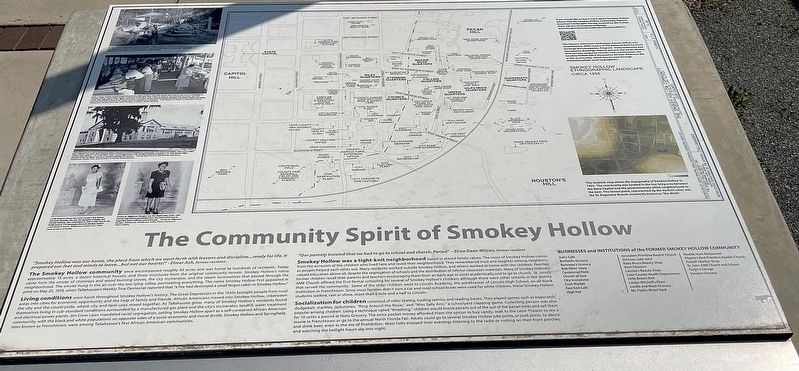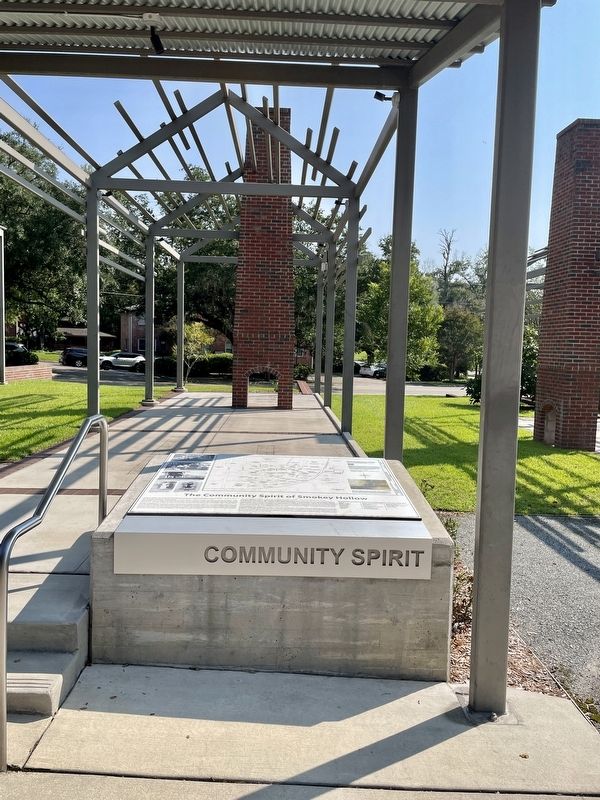Tallahassee in Leon County, Florida — The American South (South Atlantic)
The Community Spirit of Smokey Hollow
Cascades Park
"Smokey Hollow was our home, the place from which we went forth with lessons and discipline...ready for life. It prepared our feet and minds to leave...but not our hearts!" - Elmer Ash, former resident
“Our parents insisted that we had to go to school and church. Period” - Elrea Dean Wilson, former resident
The Smokey Hollow community once encompassed roughly 85 acres and was home to hundreds of residents. Today, approximately 15 acres, a dozen historical houses, and three structures from the original community remain. Smokey Hollow's name came from the smoke of chimneys and wood burning stoves, the city incinerator, and the steam locomotives that passed through the neighborhood. The smoke hung in the air over the low lying valley, permeating everything. The name Smokey Hollow first appeared in print on May 25, 1910, when Tallahassee's Weekly True Democrat reported that "a fire had destroyed a small Negro cabin in Smokey Hollow."
Living conditions were harsh throughout Smokey Hollow's history. The Great Depression in the 1930s brought people from rural areas into cities for economic opportunity and the help of family and friends. African Americans moved into Smokey Hollow, inbetween the city and the countryside, where city and farm uses mixed together. As Tallahassee grew, many of Smokey Hollow's residents found themselves living in sub-standard conditions surrounded by a manufactured gas plant and the city's incinerator, landfill, water treatment and electrical power plants. Jim Crow Laws mandated racial segregation, setting Smokey Hollow apart as a self-contained African American community, with the black and white populations on opposite sides of a socio-economic and moral divide Smokey Hollow and Springfield, later known as Frenchtown, were among Tallahassee's first African American communities.
Smokey Hollow was a tight-knit neighborhood based in shared family values. The voice of Smokey Hollow comes from the accounts of the children who lived here and loved their neighborhood. They remembered trust and laughter among neighbors as people helped each other out. Many residents worked outside Smokey Hollow, and others worked at home with the children. Families valued education above all, despite the segregation of schools and the distribution of inferior classroom materials. Many of Smokey Hollow’s former children recall the parents and teachers encouraging them from an early age to excel academically and to go to church. St. John’s AME Church offered the first formal schooling for several of Smokey Hollow's children; although there were other schools in the district that served the community. Some of the older children went to Lincoln Academy, the predecessor of Lincoln High School, an all-black institution in Frenchtown. Since most families didn't own a car and most school buses were used for white children, these Smokey Hollow students walked, rain or shine, more than a mile and a half to Lincoln.
Socialization for children consisted of roller skating, trading comics, and reading books. They played games such as hopscotch, dodgeball, marbles, jackstones, “Ring Around the Rosie” and “Miss Sally Ann,” a schoolyard clapping game. Collecting pecans was also popular among children. Using a technique called thrashing, children would knock pecans out of the pecan trees and sell them for 10 cents a pound at Nims Grocery. The extra pocket money afforded them the option to buy candy, walk to the Leon Theater to see a movie in Frenchtown or go to the annual North Florida Fair. Adults could go to several Smokey Hollow juke joints, or jook joints, to dance and drink beer, even in the era of Prohibition. Most folks enjoyed their evenings listening to the radio or visiting on their front porches, and watching the twilight hours slip into night.
Businesses and Institutions of the Former Smokey Hollow Community
Ash’s Café • Barfield’s Grocery • Barineaus’s Grocery • Bob Nims’ Store • Centennial Field • Church of God • City Incinerator • Curb Market • East End Café • High Hat • Jerusalem Primitive Baptist Church • Johnson Juke Joint • Katie Bruce Beauty Shop • Kent Cleaners • Larcina’s Beauty Shop • Leon County Heath Department • Little Brown Belt • Louise Mitchell’s Place • Lucile and Mack Grocery • Mr. Field’s Wood Yard • Mudda Hunt Restaurant • Pilgrims Rest Primitive Baptist Church • Powell’s Barber Shop • St. John AME Church and School • Taylor’s Garage • Vanzant Grocery
(captions)
Smokey Hollow residents purchased wood from woodyards within the community. The largest woodyard was Mr. Fields' Woodyard on East Street. Families picked up wood from his yard, or, using a wheelbarrow, he delivered it to people's homes. Children in Ralph Robinson's Woodyard, Tallahassee, Florida circa 1940s. Photo Courtesy of Mary E. Crumbie Williams
Once a week, farmers would bring their produce, dairy products and other goods into town to sell at the Curb Market in Smokey Hollow. Reportedly, regular customers could call in their orders in advance and pick their groceries up at the "curb," thus giving it the name. When not in use as a market, former Smokey Hollow residents remember skating and riding their bicycles in the empty aisles as children and teenagers. Curb Market on Gaines and Bloxham Streets, Tallahassee, Florida, circa 1960, State Archives of Florida, Florida Memory
Most children who grew up in Smokey Hollow attended Lincoln Academy at some point. The school was built in 1929 and enrolled children from grades 1-12. In the fall of 1955, Lincoln High School only enrolled students in grades 9-12. John Gilmore Riley, Smokey Hollow landlord, served as Lincoln's principal for 33 years. Lincoln High School at 438 West Brevard Street Tallahassee, Florida 1929, State Archives of Florida, Florida Memory
Lucille Baldwin Brown was Leon County's first African American librarian. She was the daughter of Dallas and Claudia Baldwin, who cofounded St. John's AME Church. Her family lived at 715 Suwannee Street in Smokey Hollow. Lucile Baldwin Brown, Tallahassee, Florida circa 1940s, State Archives of Florida
Oretha M. Hightower Morgan, was the Valedictorian of the 1949 Lincoln High School graduating class. She lived at 619 East St. Augustine Street with her aunt and uncle. Oretha M. Hightower Morgan, Tallahassee, Florida circa 1940s. Photo courtesy of Velma Larkins
If you would like to learn more about Smokey Hollow, please visit the Smokey Hollow Community Historic American Landscapes Survey, located on the United State Library of Congress webpage: www.loc.gov/pictures/collection/hh/item/f10781/
This isopleth map shows the topography of Smokey Hollow in 1955. The community was located in the low lying area between the State Capitol and the predominately white neighborhood to the east. The lowest point, represented by the darkest color, was the St. Augustine Branch commonly known as "the ditch".
Erected 2021 by The Tallahassee City Commission.
Topics. This historical marker is listed in these topic lists: African Americans • Parks & Recreational Areas • Settlements & Settlers.
Location. 30° 26.311′ N, 84° 16.606′ W. Marker is in Tallahassee, Florida, in Leon County. Marker can be reached from the intersection of East Pensacola Street and South Meridian Street, on the right when traveling east. Marker located within Cascades Park close to the Pensacola/Meridian Gate. Touch for map. Marker is at or near this postal address: 501-599 E Pensacola St, Tallahassee FL 32301, United States of America. Touch for directions.
Other nearby markers. At least 8 other markers are within walking distance of this marker. Althemese Pemberton Barnes Park (here, next to this marker); The Enduring Spirit of Smokey Hollow (here, next to this marker); The Family and Home Spirit of Smokey Hollow (a few steps from this marker); Smokey Hollow Spirit Houses (within shouting distance of this marker); Smokey Hollow Commemoration (within shouting distance of this marker); Smokey Hollow Barbershop (within shouting distance of this marker); John G. Riley Center & Museum of African American History & Culture (about 300 feet away, measured in a direct line); Modern Tallahassee (about 400 feet away). Touch for a list and map of all markers in Tallahassee.
Also see . . .
1. Smokey Hollow Commemoration. (Submitted on August 15, 2023, by Brandon D Cross of Flagler Beach, Florida.)
2. Cascades Park. (Submitted on August 15, 2023, by Brandon D Cross of Flagler Beach, Florida.)
Credits. This page was last revised on August 16, 2023. It was originally submitted on August 15, 2023, by Brandon D Cross of Flagler Beach, Florida. This page has been viewed 97 times since then and 19 times this year. Photos: 1, 2. submitted on August 15, 2023, by Brandon D Cross of Flagler Beach, Florida. • Bernard Fisher was the editor who published this page.

